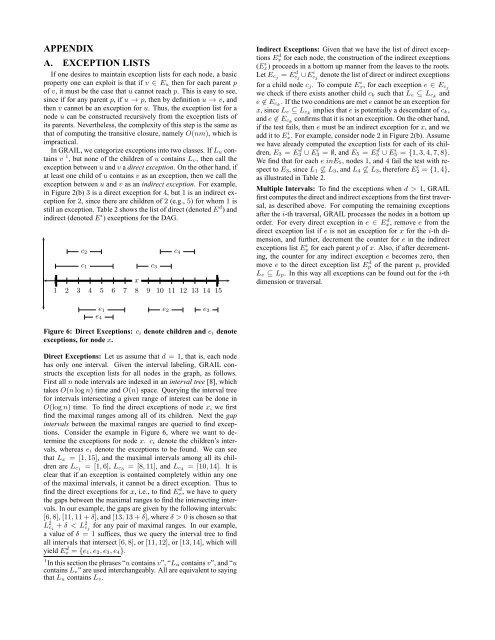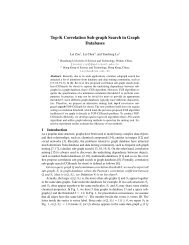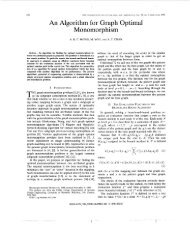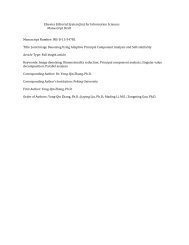GRAIL: Scalable Reachability Index for Large Graphs â - CiteSeerX
GRAIL: Scalable Reachability Index for Large Graphs â - CiteSeerX
GRAIL: Scalable Reachability Index for Large Graphs â - CiteSeerX
You also want an ePaper? Increase the reach of your titles
YUMPU automatically turns print PDFs into web optimized ePapers that Google loves.
APPENDIXA. EXCEPTION LISTSIf one desires to maintain exception lists <strong>for</strong> each node, a basicproperty one can exploit is that if v ∈ E u then <strong>for</strong> each parent pof v, it must be the case that u cannot reach p. This is easy to see,since if <strong>for</strong> any parent p, if u → p, then by definition u → v, andthen v cannot be an exception <strong>for</strong> u. Thus, the exception list <strong>for</strong> anode u can be constructed recursively from the exception lists ofits parents. Nevertheless, the complexity of this step is the same asthat of computing the transitive closure, namely O(nm), which isimpractical.In <strong>GRAIL</strong>, we categorize exceptions into two classes. IfL u containsv 1 , but none of the children of u contains L v, then call theexception betweenuandv a direct exception. On the other hand, ifat least one child of u contains v as an exception, then we call theexception between u and v as an indirect exception. For example,in Figure 2(b) 3 is a direct exception <strong>for</strong> 4, but 1 is an indirect exception<strong>for</strong> 2, since there are children of 2 (e.g., 5) <strong>for</strong> whom 1 isstill an exception. Table 2 shows the list of direct (denotedE d ) andindirect (denoted E i ) exceptions <strong>for</strong> the DAG.c 2c 3c 4c 1x1 2 3 4 5 6 7 8 9 10 11 12 13 14 15Indirect Exceptions: Given that we have the list of direct exceptionsE d x <strong>for</strong> each node, the construction of the indirect exceptions(E i x) proceeds in a bottom up manner from the leaves to the roots.LetE cj = E d c j∪E i c jdenote the list of direct or indirect exceptions<strong>for</strong> a child node c j. To compute E i x, <strong>for</strong> each exception e ∈ E cjwe check if there exists another child c k such that L e ⊆ L ck ande ∉ E ck . If the two conditions are metecannot be an exception <strong>for</strong>x, since L e ⊆ L ck implies that e is potentially a descendant of c k ,ande ∉ E ck confirms that it is not an exception. On the other hand,if the test fails, then e must be an indirect exception <strong>for</strong> x, and weadd it toE i x. For example, consider node2in Figure 2(b). Assumewe have already computed the exception lists <strong>for</strong> each of its children,E 3 = E d 3 ∪ E i 3 = ∅, and E 5 = E d 5 ∪ E i 5 = {1,3,4,7,8}.We find that <strong>for</strong> each e inE 5, nodes 1, and 4 fail the test with respectto E 3, since L 1 ⊈ L 3, and L 4 ⊈ L 3, there<strong>for</strong>e E i 2 = {1,4},as illustrated in Table 2.Multiple Intervals: To find the exceptions when d > 1, <strong>GRAIL</strong>first computes the direct and indirect exceptions from the first traversal,as described above. For computing the remaining exceptionsafter the i-th traversal, <strong>GRAIL</strong> processes the nodes in a bottom uporder. For every direct exception in e ∈ E d x, remove e from thedirect exception list if e is not an exception <strong>for</strong> x <strong>for</strong> the i-th dimension,and further, decrement the counter <strong>for</strong> e in the indirectexceptions list E i p <strong>for</strong> each parent p of x. Also, if after decrementing,the counter <strong>for</strong> any indirect exception e becomes zero, thenmove e to the direct exception list E d p of the parent p, providedL e ⊆ L p. In this way all exceptions can be found out <strong>for</strong> the i-thdimension or traversal.e 1 e 2 e 3e 4Figure 6: Direct Exceptions: c i denote children and e i denoteexceptions, <strong>for</strong> node x.Direct Exceptions: Let us assume that d = 1, that is, each nodehas only one interval. Given the interval labeling, <strong>GRAIL</strong> constructsthe exception lists <strong>for</strong> all nodes in the graph, as follows.First all n node intervals are indexed in an interval tree [8], whichtakes O(nlogn) time and O(n) space. Querying the interval tree<strong>for</strong> intervals intersecting a given range of interest can be done inO(logn) time. To find the direct exceptions of node x, we firstfind the maximal ranges among all of its children. Next the gapintervals between the maximal ranges are queried to find exceptions.Consider the example in Figure 6, where we want to determinethe exceptions <strong>for</strong> node x. c i denote the children’s intervals,whereas e i denote the exceptions to be found. We can seethat L x = [1,15], and the maximal intervals among all its childrenare L c1 = [1,6], L c3 = [8,11], and L c4 = [10,14]. It isclear that if an exception is contained completely within any oneof the maximal intervals, it cannot be a direct exception. Thus tofind the direct exceptions <strong>for</strong> x, i.e., to find E d x, we have to querythe gaps between the maximal ranges to find the intersecting intervals.In our example, the gaps are given by the following intervals:[6,8],[11,11+δ], and[13,13+δ], whereδ > 0 is chosen so thatL 2 c i+ δ < L 2 c j<strong>for</strong> any pair of maximal ranges. In our example,a value of δ = 1 suffices, thus we query the interval tree to findall intervals that intersect [6,8], or [11,12], or [13,14], which willyieldE d x = {e 1,e 2,e 3,e 4}.1 In this section the phrases “u containsv”, “L u containsv”, and “ucontainsL v” are used interchangeably. All are equivalent to sayingthat L u contains L v.












